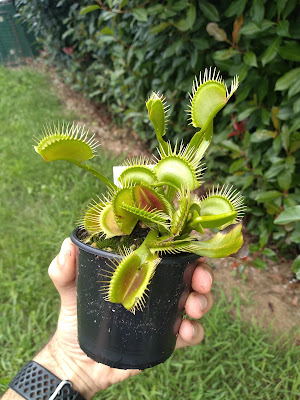Late last year I bought a DCXL Venus Flytrap. I have not been growing it for very long, and my plant has not yet demonstrated its true potential, but already it is one of my favourite Venus flytraps.
DCXL has upright summer growth, and is meant to die down to have low growth over winter. The traps are rather large, even on my young plant, and it puts out a lot of traps. The traps don't have a huge amount of colour, but they make up for it with their large size. So far mine is upright but has not grown overly tall, but I can see its potential for growing very tall once established.
My plant arrived in the mail rather small, and has exploded in growth, faster than any venus flytrap I have seen. It is pretty impressive how quickly it grew from a tiny thing into a large impressive plant.
 |
Venus Flytrap DCXL big and beefy
|
My plant attempted to flower not too long after I got it. I cut off the stalk as I wanted my plant to focus on getting strong and healthy rather than flowering and producing seed. I planted the stalk, and it has produced a few baby DCXL plants from that cut off flower stalk.
My DCXL plant also appears to be dividing. So far there are two large divisions in that pot and maybe the start of a third smaller one. I will be interested to see how many divisions it will produce between now and winter as I hope to grow a few more of these in my collection.
 |
Venus Fly trap DCXL
|
I am not great at describing these plants, so have cut and paste some descriptions that I found which were written by people far more knowledgeable than I am.
Flytrapstore.com description:
This is it! THE LARGEST TRAPS WE'VE EVER SEEN!
Out of the thousands of flytraps we have growing here at FlytrapStore,
DC XL grows the largest traps of any flytrap we've ever grown. The first
traps in spring are usually the largest and can approach 2 inches in
size on a fully grown DC XL flytrap. In addition to being ginormous for a
Venus flytrap, DC XL is also an extraordinarily hardy grower, more than
any other type we know of. DC XL is a handsome hardy monster flytrap,
and we learn to love it more and more as we watch it grow over the
seasons.
DC XL produces the largest traps we've ever seen! A giant monster of a
plant. Grow one and judge for yourself! The "XL," in case it wasn't
obvious, stands for X-tra Large.
The challenger to B52
for the "world's largest traps" title. The "DC" in DC XL is for David
Conner, the original source for the single plant of DC XL we obtained
and subsequently grew and propagated in tissue culture in the
FlytrapStore Lab. David Conner is also the original tissue-culture
source of the famous B52 Venus Flytrap.
I also could paraphrase the history of the DCXL VFT, but thought I could just cut and paste directly from the source. Flytrapcare.com gave a bit of a description of its history:
A few years ago before I knew Matt and was raising and selling Venus
Flytraps as the Flytrap Ranch, I bought quite a few young B52 Venus
Flytraps from David Conner. He was the original tissue-culture
propagator of that great clone, and I'm still grateful to him just from a
personal perspective for helping to generate enough for B52 to become
widely distributed and cultivated, now in many countries, not just its
home country of the United States.
When I received one of my orders from David, he included several gift
plants, single young plants of specific Venus Flytrap clones he was
thinking of tissue culturing. One of them was "All Red" (which Matt is
propagating and we are growing for sale, a magnificent deep red clone
whose name we added the prefix "DC" to in order to identify its source),
another was "Giant Red," which turned out to be disappointing after
growing it for several seasons, and another was the XL (which we've
added the "DC" to to indicate the source).
The XL (now DC XL) grew very vigorously that first year and divided into
several plants. I was impressed with its growth. The second growing
season, it produced the sturdiest wide leaves, with the largest midrib
(the vein that runs the length of the leaf), most vigorous growth after
dormancy and the largest traps I had ever seen on a plant that was still
immature. Matt used a flowerstalk of DC XL (right, Matt?) to get the
plant into viable (noncontaminated) sterile culture and has been
propagating it since.
 |
Venus Flytrap DCXL - a large robust carnivorous plant
|
I myself don't currently have any carnivorous plants in tissue culture. I grow all my named venus flytrap plants from divisions, leaf pullings, or flower stalk cuttings. This means increasing numbers can be slow, but I am growing them as a hobby so I don't need to produce thousands of them.
I can't help but notice the price of these has gone up since I bought my plant, the average price in Australia being $50 plus postage for one small juvenile plant! In my opinion that is far too much for a flytrap. I hope to divide my DCXL vft and have a few plants to grow for myself, but I may be able to produce a few extras on top of that.
When I have any extras I might list them on my for sale page but the price won't be as high. I have a few other named varieties of venus flytrap and other carnivorous plants for sale, or I would be willing to consider a trade for other interesting plants.


















































